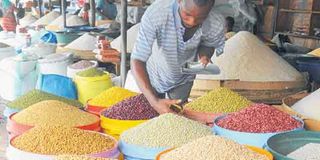Food prices up 15pc, says BoT report

A trader arranges cereals for sale at the Kisutu Market in Dar es Salaam. PHOTO|FILE
What you need to know:
The most affected segment of the population are poor and low income earners, who are forced to squeeze their spending on other basic needs – doing so at the expense of rising food prices.
Dar es Salaam. Consumers spent more cash to purchase staple food commodities in markets and shops in July this year, compared with the same month last year, the Bank of Tanzania (BoT) has said.
The most affected segment of the population are poor and low income earners, who are forced to squeeze their spending on other basic needs – doing so at the expense of rising food prices.
The central bank’s Monthly Economic Review for August showed that wholesale prices for three staple crops -- namely maize, rice and beans – increased by an average of 15 per cent during the year that ended on July 31, 2017, compared with the similar period last year.
The highest increases were recorded on the main staple maize, whose wholesale price increased by 25.8 per cent to Sh67,915 per 100 kilogrammes last July, compared with the Sh53,984 recorded in July last year.
Maize production for 2017 was earlier tentatively forecast at 5.5 million tonnes: three percent below the average production for the previous five years. The domestic maize demand in Tanzania is estimated at 5.2 million tonnes per annum.
Reduced production output was mainly on account of poor rains in some central and northern parts of the country, according to the Food and Agriculture Organisation (FAO) report for August this year.
“In the northern and eastern bi-modal rainfall areas, ‘Masika’ rain crops, planted between February and March were in the harvesting stage. In northern Tanzania, crop development was negatively affected by below-average rains, whereby the March-to-May seasonal rainfall was 20-35 per cent below average in the Arusha, Mwanza and Shinyanga regions,” says FAO.
In central and southern uni-modal rainfall areas, the major ‘Msimu’ maize harvesting started in June, after a delay of more than one month, as dry weather conditions between December 2016 and February 2017 hampered planting operations and early crop development.
Average-to-above-average rainfall from late February to May reduced soil moisture deficits and lifted production prospects in southern key-growing areas, including the Mbeya, Rukwa, Katavi and Iringa administrative regions.
For rice – which is also widely consumed in both urban and rural areas of Tanzania – increased by 15 per cent during the year to July 31 this year rising to Sh170,737 per 100 kilogramme, up from Sh148,128 in July last year.
The review further shows that the wholesale price for beans also increased by ten per cent during the period under review, rising to Sh165,056 per 100 kilogramme in July this year, up from the Sh149,124 recorded during similar period last year.
The National Bureau of Statistics (NBS) price statistics for last August indicated that the prices for food and non-alcoholic beverages increased by an average rate of 8.9 per cent in July, compared with July last year.
The food index – which account for 39 per cent of all people’s consumption – increased to 114.20 points in July this year, rising from the 105.00 points recorded during the same month last year.
This is happening at a time when consumers are facing cash shortages due to tight monetary policy. The situation has badly affected consumers’ ability to purchase both food and non-food commodities.
However, on a monthly basis, the report shows decreased prices for the same staple food commodities. Wholesale prices for maize went down by 17 per cent in July compared with the June prices.
The slight price reduction in July over June was the result of the May-to-July (Msimu) harvest in the main producing regions in southern Tanzania, which accounts for approximately 75 per cent of the total annual food production.
According to the report, rice prices slightly decreased by 1.1 per cent in July compared with June this year, while the wholesale price for beans went down by 3.9 per cent in July compared with June this year.
An official with the ministry of trade, industries and investments said the annual increases in food prices were the result of lower harvests caused by prolonged drought in key producing areas.
Reports say that, in many parts of the bimodal rainfall areas – including the administrative regions of Morogoro, Geita, Shinyanga and Tanga – maize experienced ‘watch conditions’ due to the poor distribution of rains.
In the unimodal areas, parts of Dodoma and Tabora experienced ‘watch conditions’ for maize due to delayed rainfall, and poor distribution of Msimu rainfall.
However, other parts of unimodal areas – such as Katavi, Rukwa, Ruvuma, Njombe, Mbeya and Kigoma – experienced favourable and exceptional conditions following good performance of the ‘Msimu’ rains. The Famine Early Warning System network of the USAID published in September indicated that maize supplies in East Africa were generally below average – thus causing a rise in average prices.




